As minimum tillage reseeding methods continue to gain popularity on livestock farms around the country, Murphy Machinery offered us a demonstration of Alpego’s latest IZ Inversa stone burier to showcase its versatility and potential in a reseeding operation.
For those unaware, a stone burier is an implement used for soil preparation, particularly in tasks such as burying stones and debris in seedbed preparation for seeding.
The Kilkenny-firm is the Irish importer for Alpego. Since the new Inversa stone burier was released in late 2021, the firm has sold in the region of 20 in Ireland.
They are not used alone in the cultivation process, but Murphy’s have sold almost all Inversas to date with air seeders, where a share of these machines are being used to reseed ley ground in a one-pass operation.
Who is Alpego?
Alpego is a machinery manufacturer based in northern Italy. The firm’s pedigree dates back to 1946, when it started manufacturing agricultural equipment.

The Inversa carried out a super job in this thrashy, peaty ley in a single pass.
In 1988, the Alpego brand was created. In 1991, it built its first foldable power harrow, followed by its first combined broadcast seed-drill in 1998. In 2007, its export turnover exceeded 50% of the production.
This year, it started construction of its fourth production site. Today, the Pegoraro family still own the company, and its machines are sold in over 40 countries worldwide.
With subsidiaries in Italy, France and the UK, the firm employs over 200 people.
Workings of the machine
For those not so familiar, a stone burier is very similar to a rotavator, except that the tilling rotor rotates in the same direction of the tractor, and its construction is that little bit beefier.

It produced a lovely finish in this well-decayed disced ley, at a forward speed of 5.5km/h.
The IZ Inversa is designed for burying stones, clods and crop residuals. Fitted with a sorting grid and a leveling bar, it is designed to bring the refined, thinner soil back to the surface.
Alpego’s range of rotary tillers is equipped with its patented central gear transmission, which runs in an oil bath.
Designed and built in-house, the vertically arranged gears are made of cast iron.
The machine is designed to work in contact with the moving soil, which allows for natural heat dispersion.
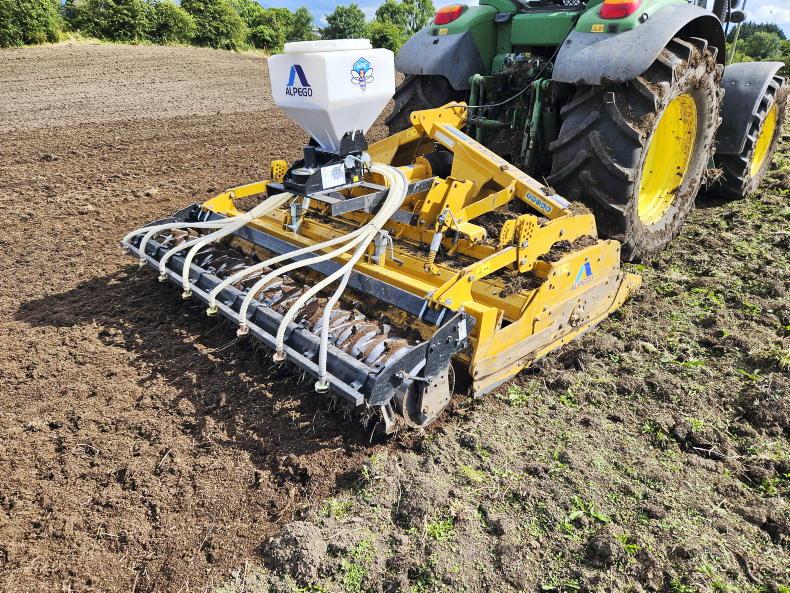
It weighs in at 2,150kg, but it's longer than you’d think, and sits back a nice distance from the tractor's linkage.
All drive shafts on Inversa destined for Ireland are fitted with automatic cam clutches over a traditional slip clutch. The central drive powers 33 blades either side of the gearbox.
The curved L-shaped blades are made from hardened tungsten steel. It comes with the choice of a cage, spiral, spike or packer roller, with the latter featured on the machine we tried out.
In the field
Over the course of our trial, we put the machine through almost 50 acres, mixed between ley ground and disced ground.

The sorting grid and leveling bar do a great job at bringing the refined, thinner soil back to the surface.
In ley ground, we achieved outputs of 1.5 to 2.5 acres/hour.
Field size and soil type had a big affect on throughput capacity. In disced ground, forward speed and output was significantly higher.
Working depth wasn’t as deep, and the looseness made it much easier to bump forward speed up to 5.5km/h to 6km/h.
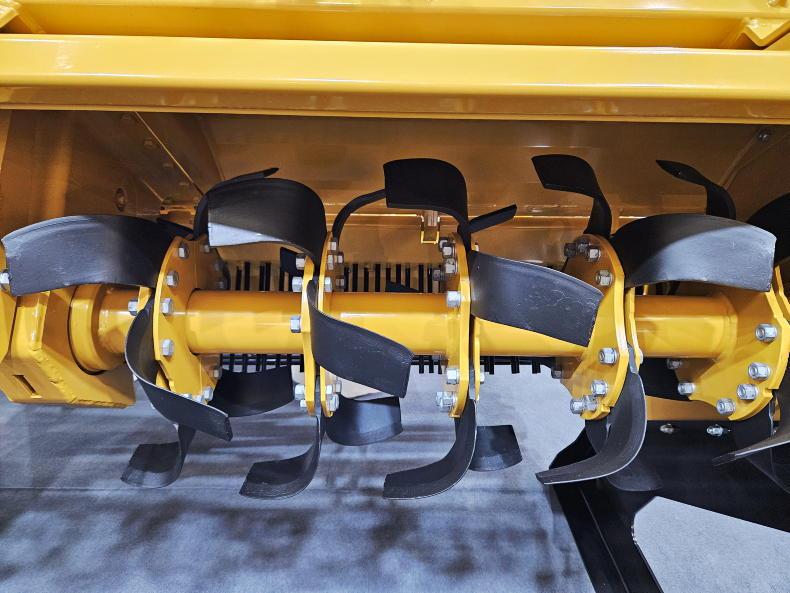
The curved L-shaped blades are made of hardened tungsten steel.
One run through a field that had been disced twice and left to further decay produced super results.
When working on hire in ley ground that you’re not familiar with, you always face the possibility of hitting stones.
When it came into contact with larger stones, the slip clutch would trip. Working at slower speeds in ley ground produced very good results, but as you can imagine, running the 1,000-rpm gearbox, it was thirsty on fuel.
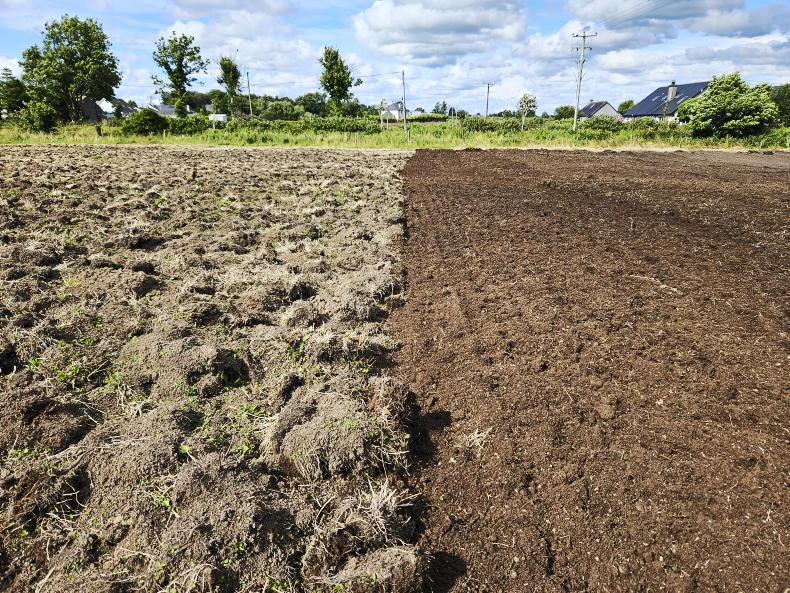
One run through a field that was disced twice and left to further decay produced super results.
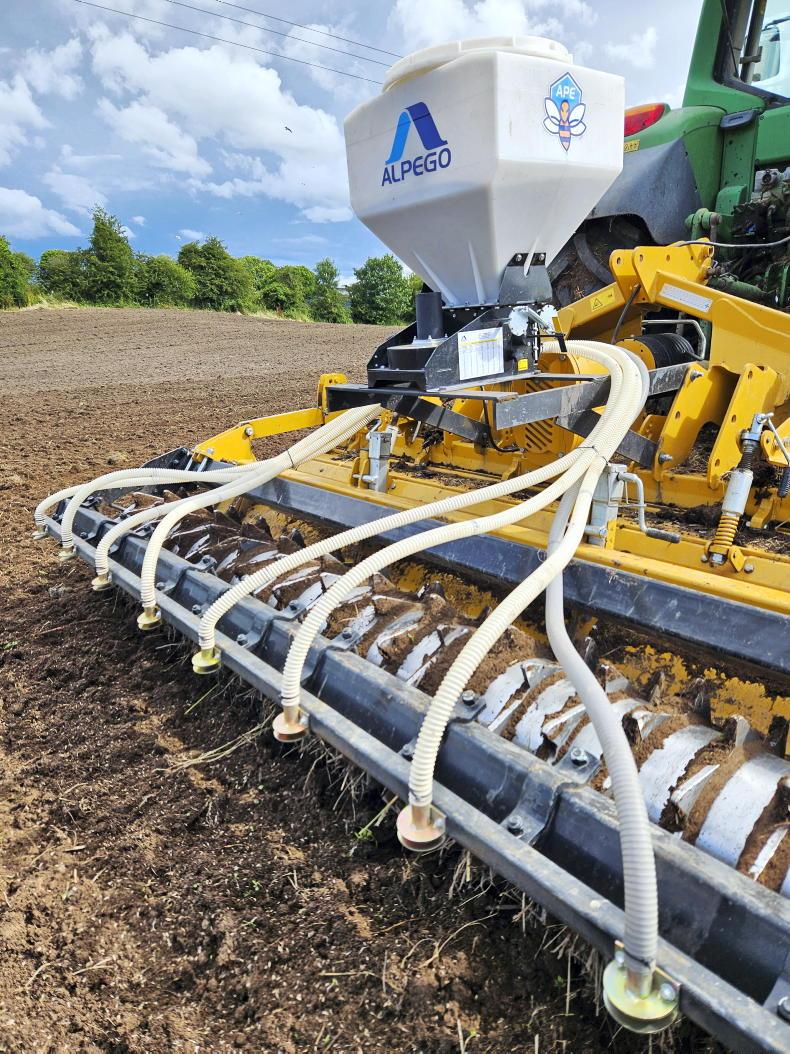
It was fitted with an entry-level air seeder from Alpego, which worked fine.
One section of peaty ley ground we tackled hadn’t been reseeded in donkeys’ years. There were 18 inches of dense rushes, which was sprayed off, mowed and removed from the field.
What we were left with was a thrashy, but well-decayed butt.
Min-till was on the cards with the farmer, so we tried to give it a run of the disc, but didn’t achieve much.
As seen from the photo, the Inversa carried out a super job in a single pass. On a different plot in a loamy-type soil with a tough scraw, one-pass didn’t offer as good of a result. Like any type of min-till reseeding job, the less thrash, the better.
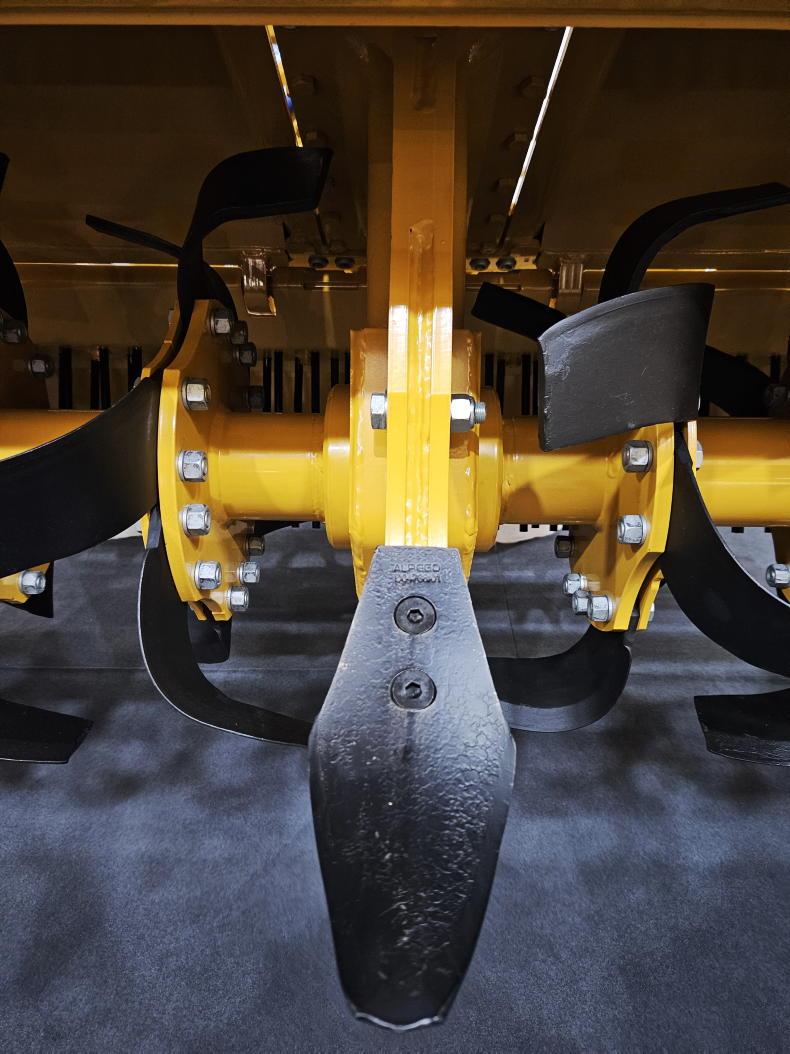
A tooth splits the ground ahead of the central drive.
In ley ground, the only problem I encountered with the finish was the side boards, which were inclined to leave a little ridge behind the machine. If the weather is good enough to allow you to give it a roll afterwards, then all is good.
But when using it as a one-pass grassland reseeding option with the rain at your back, this wasn’t ideal.
When mentioned to Alpego, they dug two optional extras out of the bag to help deal with this. The first are skids, which keep the tilling that bit shallower when the full depth isn’t necessary.
The second is a disc kit, which sits either side of the machine, guiding the scraw into the rotor.
The machine has a working depth range from 80mm to 250mm.
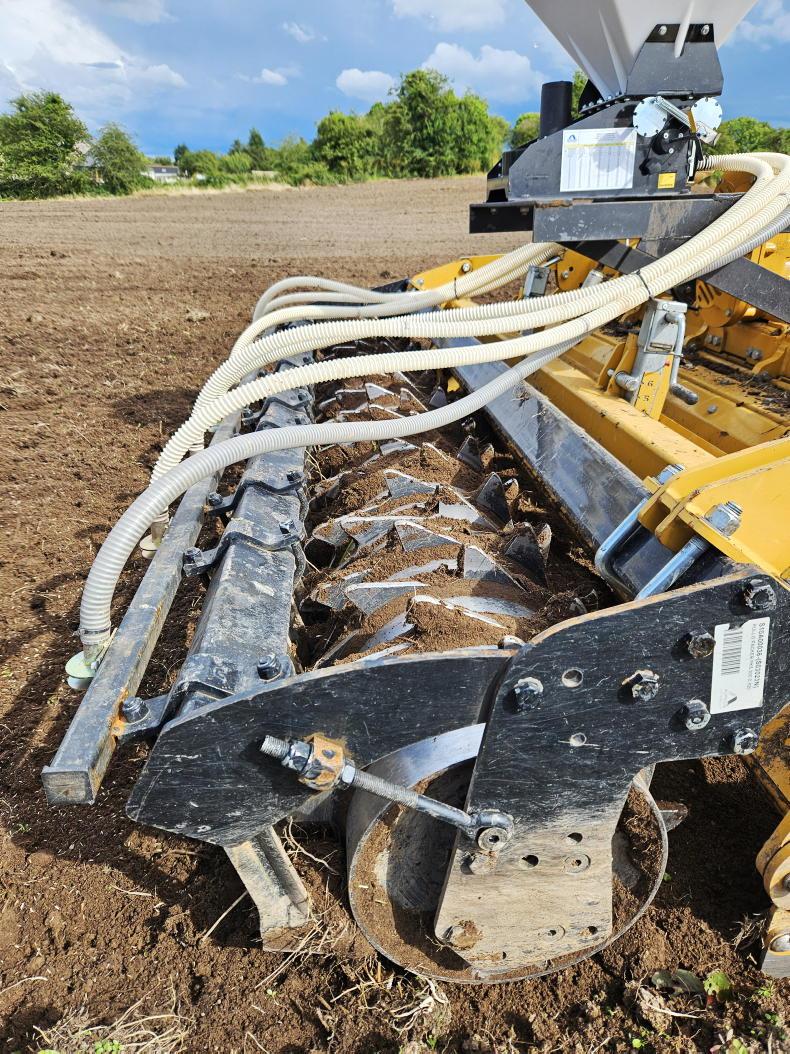
Our demonstration machine came with the packer roller option.
We worked it at its shallowest, which we felt was still a little on the deep side, in some jobs. The only hesitation I had when sowing grass seed with it was that the seedbed could have done with a little bit more consolidation.
Speaking with Michael Cahill, who has been running the machine for two seasons, we both agreed that the ideal setup if you wanted to tackle clean ley ground in good conditions, would comprise one run of the Inversa, followed by sowing with a seeder mounted on a ring roller.

The control box for the air seeder. Simple, but effective.
On the flip side, one thing to note is that with the huge amount of clay you’re moving in one-pass, coupled with the correct setting of the leveling bar, it does a great job leveling rough ground.
Perhaps a heavy rubber-packer roller, or a double-packer roller might help with reconsolidation.
We operated the machine on a John Deere 6830, which has a few extra ponies under the bonnet than it was originally given by Deere at Manheim.
We reckon that you’d want 160hp-plus to operate the machine, but it’s weight that you need for lifting and transporting it on the road.
Weighing in at 2,150kg, Alpego didn’t spare the metal. However, the machine is long and sits back a nice distance from the tractor’s linkage.
From speaking to contractors, the going rate for these machines is from €70 to €85, plus VAT an acre, depending on the job at hand.
The Inversa is well-built and it’s a truly versatile machine. It offers more flexibility over a power harrow, but this comes at an added cost.
Roughly speaking, a heavy-duty stone burier would set you back around €2,000 to €3,000 plus VAT more than a new power harrow would.

The Inversa offers more flexibility over a power harrow, but would set you back around €2,000 to €3,000 plus VAT more than a new power harrow.
One point to note is that individual replacement blades come in at about 50% cheaper than power harrow tines. The Inversa is a machine that the operator needs to understand to get the most out of it.
It’s not a ‘one machine fits all’ answer, but it’s a tool that will add huge flexibility to a contractor’s reseeding business.
Farmer comment: Michael Cahill, Moneygall, Co Offaly
Michael Cahill is a dairy farmer calving 210 cows in a year-round milking system. With a big emphasis on grass quality and silage quality, he carries out all these works himself using his own machinery.
Reseeding in the region of 30ac each year, he would normally use the traditional plough, till and sow method, or min-till (discing).
With a lot of gravelly-type soil on the farm, he attended a demonstration in 2021 where he first saw the Inversa working. Very impressed, he then bought the demonstration machine. First putting it to work early in 2022, he has since clocked up over 200ac with the machine. This was split between his own work and some local hire work.
Michael has used the machine to tackle straight ley ground, disced ground and ploughed ground. The machine was bought in particular to tackle a rough 33ac hilly field which had a fair share of gravelly-type soil in it. It took 17 hours to complete one pass of the 33ac field, but he said it did an unbelievable job of leveling the field.
Michael has a Guttler air seeder mounted on his machine, but due to the depth Inversa works at, he feels that there’s not enough seedbed consolidation after the packer roller, so tends to sow with his power harrow and air seeder, which is fitted with a rubber-packer roller.
“As you’re working at a good depth, there is a lot of soil moving. Once the conditions are dry, the leveling bar will do a serious job at leveling the ground. The machine has the capacity to handle stones up to the size of your boot, so eight or nine inches.
"Anything bigger needs to be picked. The blades are expensive, so you don’t want to break them. After 200ac, our machine is still on its full set of original blades. I reckon that I would get another 100ac of hard ley ground through it, or 200-250ac of tilled/stubble ground through it, no bother.
“In ley ground, our forward speed is around 2km/h. In ground where cattle were outwintered on a catch crop or in ploughed ground, you would push this up to 5-6km/h. I bought the machine, as the traditional plough-till-sow method was taking up too much time.
"I run it on a Deutz 6185. It needs all the weight and power. On a long day, it would empty the 320l diesel tank. Overall, the Inversa is a brilliant tool. The only thing I have against it is its weight – it’s heavy”, concluded Michael.
Likes
Versatility. Build quality.Ability to level rough ground.Runs very smoothly.Dislikes
Heavy. The spec
Model: Inversa IZ-300.Recommended horsepower: 170hp-plus.Gearbox: 1000 RPM.Number of blades: 33 each side of the gearbox (66 in total).Working width: 2,930mm.Working depth: 250mm.Weight: 2,150kg (with packer roller).Price: €26,000 plus VAT. Optional basic air seeder: €6,000 plus VAT.
As minimum tillage reseeding methods continue to gain popularity on livestock farms around the country, Murphy Machinery offered us a demonstration of Alpego’s latest IZ Inversa stone burier to showcase its versatility and potential in a reseeding operation.
For those unaware, a stone burier is an implement used for soil preparation, particularly in tasks such as burying stones and debris in seedbed preparation for seeding.
The Kilkenny-firm is the Irish importer for Alpego. Since the new Inversa stone burier was released in late 2021, the firm has sold in the region of 20 in Ireland.
They are not used alone in the cultivation process, but Murphy’s have sold almost all Inversas to date with air seeders, where a share of these machines are being used to reseed ley ground in a one-pass operation.
Who is Alpego?
Alpego is a machinery manufacturer based in northern Italy. The firm’s pedigree dates back to 1946, when it started manufacturing agricultural equipment.

The Inversa carried out a super job in this thrashy, peaty ley in a single pass.
In 1988, the Alpego brand was created. In 1991, it built its first foldable power harrow, followed by its first combined broadcast seed-drill in 1998. In 2007, its export turnover exceeded 50% of the production.
This year, it started construction of its fourth production site. Today, the Pegoraro family still own the company, and its machines are sold in over 40 countries worldwide.
With subsidiaries in Italy, France and the UK, the firm employs over 200 people.
Workings of the machine
For those not so familiar, a stone burier is very similar to a rotavator, except that the tilling rotor rotates in the same direction of the tractor, and its construction is that little bit beefier.

It produced a lovely finish in this well-decayed disced ley, at a forward speed of 5.5km/h.
The IZ Inversa is designed for burying stones, clods and crop residuals. Fitted with a sorting grid and a leveling bar, it is designed to bring the refined, thinner soil back to the surface.
Alpego’s range of rotary tillers is equipped with its patented central gear transmission, which runs in an oil bath.
Designed and built in-house, the vertically arranged gears are made of cast iron.
The machine is designed to work in contact with the moving soil, which allows for natural heat dispersion.

It weighs in at 2,150kg, but it's longer than you’d think, and sits back a nice distance from the tractor's linkage.
All drive shafts on Inversa destined for Ireland are fitted with automatic cam clutches over a traditional slip clutch. The central drive powers 33 blades either side of the gearbox.
The curved L-shaped blades are made from hardened tungsten steel. It comes with the choice of a cage, spiral, spike or packer roller, with the latter featured on the machine we tried out.
In the field
Over the course of our trial, we put the machine through almost 50 acres, mixed between ley ground and disced ground.

The sorting grid and leveling bar do a great job at bringing the refined, thinner soil back to the surface.
In ley ground, we achieved outputs of 1.5 to 2.5 acres/hour.
Field size and soil type had a big affect on throughput capacity. In disced ground, forward speed and output was significantly higher.
Working depth wasn’t as deep, and the looseness made it much easier to bump forward speed up to 5.5km/h to 6km/h.

The curved L-shaped blades are made of hardened tungsten steel.
One run through a field that had been disced twice and left to further decay produced super results.
When working on hire in ley ground that you’re not familiar with, you always face the possibility of hitting stones.
When it came into contact with larger stones, the slip clutch would trip. Working at slower speeds in ley ground produced very good results, but as you can imagine, running the 1,000-rpm gearbox, it was thirsty on fuel.

One run through a field that was disced twice and left to further decay produced super results.

It was fitted with an entry-level air seeder from Alpego, which worked fine.
One section of peaty ley ground we tackled hadn’t been reseeded in donkeys’ years. There were 18 inches of dense rushes, which was sprayed off, mowed and removed from the field.
What we were left with was a thrashy, but well-decayed butt.
Min-till was on the cards with the farmer, so we tried to give it a run of the disc, but didn’t achieve much.
As seen from the photo, the Inversa carried out a super job in a single pass. On a different plot in a loamy-type soil with a tough scraw, one-pass didn’t offer as good of a result. Like any type of min-till reseeding job, the less thrash, the better.

A tooth splits the ground ahead of the central drive.
In ley ground, the only problem I encountered with the finish was the side boards, which were inclined to leave a little ridge behind the machine. If the weather is good enough to allow you to give it a roll afterwards, then all is good.
But when using it as a one-pass grassland reseeding option with the rain at your back, this wasn’t ideal.
When mentioned to Alpego, they dug two optional extras out of the bag to help deal with this. The first are skids, which keep the tilling that bit shallower when the full depth isn’t necessary.
The second is a disc kit, which sits either side of the machine, guiding the scraw into the rotor.
The machine has a working depth range from 80mm to 250mm.

Our demonstration machine came with the packer roller option.
We worked it at its shallowest, which we felt was still a little on the deep side, in some jobs. The only hesitation I had when sowing grass seed with it was that the seedbed could have done with a little bit more consolidation.
Speaking with Michael Cahill, who has been running the machine for two seasons, we both agreed that the ideal setup if you wanted to tackle clean ley ground in good conditions, would comprise one run of the Inversa, followed by sowing with a seeder mounted on a ring roller.

The control box for the air seeder. Simple, but effective.
On the flip side, one thing to note is that with the huge amount of clay you’re moving in one-pass, coupled with the correct setting of the leveling bar, it does a great job leveling rough ground.
Perhaps a heavy rubber-packer roller, or a double-packer roller might help with reconsolidation.
We operated the machine on a John Deere 6830, which has a few extra ponies under the bonnet than it was originally given by Deere at Manheim.
We reckon that you’d want 160hp-plus to operate the machine, but it’s weight that you need for lifting and transporting it on the road.
Weighing in at 2,150kg, Alpego didn’t spare the metal. However, the machine is long and sits back a nice distance from the tractor’s linkage.
From speaking to contractors, the going rate for these machines is from €70 to €85, plus VAT an acre, depending on the job at hand.
The Inversa is well-built and it’s a truly versatile machine. It offers more flexibility over a power harrow, but this comes at an added cost.
Roughly speaking, a heavy-duty stone burier would set you back around €2,000 to €3,000 plus VAT more than a new power harrow would.

The Inversa offers more flexibility over a power harrow, but would set you back around €2,000 to €3,000 plus VAT more than a new power harrow.
One point to note is that individual replacement blades come in at about 50% cheaper than power harrow tines. The Inversa is a machine that the operator needs to understand to get the most out of it.
It’s not a ‘one machine fits all’ answer, but it’s a tool that will add huge flexibility to a contractor’s reseeding business.
Farmer comment: Michael Cahill, Moneygall, Co Offaly
Michael Cahill is a dairy farmer calving 210 cows in a year-round milking system. With a big emphasis on grass quality and silage quality, he carries out all these works himself using his own machinery.
Reseeding in the region of 30ac each year, he would normally use the traditional plough, till and sow method, or min-till (discing).
With a lot of gravelly-type soil on the farm, he attended a demonstration in 2021 where he first saw the Inversa working. Very impressed, he then bought the demonstration machine. First putting it to work early in 2022, he has since clocked up over 200ac with the machine. This was split between his own work and some local hire work.
Michael has used the machine to tackle straight ley ground, disced ground and ploughed ground. The machine was bought in particular to tackle a rough 33ac hilly field which had a fair share of gravelly-type soil in it. It took 17 hours to complete one pass of the 33ac field, but he said it did an unbelievable job of leveling the field.
Michael has a Guttler air seeder mounted on his machine, but due to the depth Inversa works at, he feels that there’s not enough seedbed consolidation after the packer roller, so tends to sow with his power harrow and air seeder, which is fitted with a rubber-packer roller.
“As you’re working at a good depth, there is a lot of soil moving. Once the conditions are dry, the leveling bar will do a serious job at leveling the ground. The machine has the capacity to handle stones up to the size of your boot, so eight or nine inches.
"Anything bigger needs to be picked. The blades are expensive, so you don’t want to break them. After 200ac, our machine is still on its full set of original blades. I reckon that I would get another 100ac of hard ley ground through it, or 200-250ac of tilled/stubble ground through it, no bother.
“In ley ground, our forward speed is around 2km/h. In ground where cattle were outwintered on a catch crop or in ploughed ground, you would push this up to 5-6km/h. I bought the machine, as the traditional plough-till-sow method was taking up too much time.
"I run it on a Deutz 6185. It needs all the weight and power. On a long day, it would empty the 320l diesel tank. Overall, the Inversa is a brilliant tool. The only thing I have against it is its weight – it’s heavy”, concluded Michael.
Likes
Versatility. Build quality.Ability to level rough ground.Runs very smoothly.Dislikes
Heavy. The spec
Model: Inversa IZ-300.Recommended horsepower: 170hp-plus.Gearbox: 1000 RPM.Number of blades: 33 each side of the gearbox (66 in total).Working width: 2,930mm.Working depth: 250mm.Weight: 2,150kg (with packer roller).Price: €26,000 plus VAT. Optional basic air seeder: €6,000 plus VAT. 
















 This is a subscriber-only article
This is a subscriber-only article










SHARING OPTIONS: